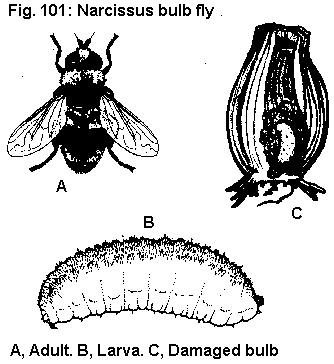 Fig. 101: Narcissus Bulb Fly,
Fig. 101: Narcissus Bulb Fly, Merodon equestris (Fabricius), Syrphidae, DIPTERA
Return to: CFREC Home Page
Adult - Narcissus bulb flies are 9 to 12 mm flies that resemble bumble bees although some individual flies are more reddish brown, orange, or tan than the species of bumble bees that occur in the southeastern United States. Unlike bumble bees, narcissus bulb flies have a very rapid flight and also tend to hover in flight. Narcissus bulb flies also show a marked preference for narcissus plants whereas bumble bees usually forage on flowers.
Egg - Narcissus bulb fly eggs are white and slender and about 1.5 mm long. They usually occur on the host plant leaves close to the soil.
Larva - Newly hatched maggots are about I mm long. Third stage maggots are about 19 mm long and are a dirty tan. The maggot is plump and slightly arched. The skin is tough and wnnkled. The mouth hooks and breathing tube are almost black.
Pupa - The pupa occurs in the last larval skin. The skin becomes a tough, brown, 13 by 7 mm case (puparium) inside of which the relatively delicate pupa develops.
 Fig. 101: Narcissus Bulb Fly,
Fig. 101: Narcissus Bulb Fly,
Merodon equestris (Fabricius), Syrphidae, DIPTERA
A, Adult. B, Larva. C, Damaged narcisus bulb.
Distribution - The narcissus bulb fly occurs wherever narcissus are grown throughout the United States. This pest was introduced from Europe in about 1869.
Host Plants - The narcissus bulb fly has been reported to infest amaryllis, daffodil, Galtonia, Flanthus, hyacinth, Iris, lilies, Leucofum, Narcissus, Scilla, tulips, and Vallota.
Damage - The center of the bulb is hollowed out and the flower bud is destroyed. Many infested bulbs rot away although some survive to send up a few scrawny grasslike blades the following year.
Life History - Narcissus bulb flies now occur throughout the world wherever narcissus are grown. In the United States, narcissus had been virtually pest free here until the fly was introduced. Narcissus bulb flies emerge from the soil usually in May. After mating, females lay one to three eggs between the sheath and stem of each bulb or between the layers of skin enclosing the neck of the bulb. Females lay from 40 to 100 eggs each. Ten days to 2 weeks later the eggs hatch and the tiny maggots bore down through the outer bulb scales to the basal plate where they tunnel extensively for some time. Later they bore
directly inside the bulb. The maggots develop rapidly in the next two months and become virtually fully grown, although they do not pupate until the following spring. Usually only one maggot develops per bulb although more are occasionally found. Five to 7 weeks are spent in the pupal stage before a new generation of adults emerges. There is one generation per year although some individuals require 2 years to mature.
Control of the narcissus bulb fly is not easy. The insect has few natural enemies. Cultural controls include mowing the leaves as soon as they dry in late spring and then cultivating the soil lightly to prevent the females from finding the holes left by the leaves. Lifting the bulbs as soon as the tops die back and then sorting out and destroying infested bulbs should also help to decrease the population for the following year. Catching the flies in an insect net and destroying them should also help to decrease the population (each female destroyed means 100 potential maggots are destroyed).
A hot water bath has also been found to be effective in killing maggots in infested bulbs. Maggots can be killed if bulbs are submerged in water kept at about 43 to 44C for 40 minutes. Care must be taken to avoid overheating the bulbs even for a short time as the bulbs may be adversely affected by high temperatures. For chemical control, drench a mixture of insecticides and water in early May. For specific chemical control recommendations, see your Cooperative Extension publications on ornamental plant pest management.
Reference to University of Florida/IFAS Pest Control Guides